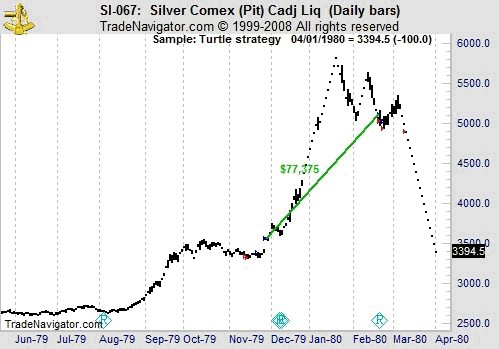
Turtle Trading Strategy in Forex
The turtle experiment, also known as the turtle traders experiment, was a trading experiment conducted by Richard Dennis and William Eckhardt in 1983 to determine if trading could be taught. Dennis, a successful commodities trader, believed that trading was a skill that could be learned, while Eckhardt believed that trading was a talent that people were born with.
Key points
The Turtle Trading experiment conducted by Richard Dennis and William Eckhardt was a resounding success.
The effectiveness of the Turtle Trading system has been called into question in modern markets due to constantly changing conditions.
The Turtle Trading system is based on buying a stock or contract when it breaks out and quickly selling it when the price retraces or falls.
The Turtle Trading system is widely recognized as one of the most popular trend-following strategies.
The Turtle Trading Strategy Experiment
In the early 1980s, Richard Dennis, a successful trader, believed that anyone could be taught to trade the futures markets, but his partner, William Eckhardt, disagreed.
To settle their debate, Dennis set up an experiment to teach his trading rules to a group of people and have them trade with real money.
Dennis gave the traders his own money to trade, and they were called “turtles” after turtle farms Dennis had visited in Singapore.
The training lasted for two weeks and could be repeated, and Dennis believed that he could grow traders as quickly and efficiently as farm-grown turtles.
Find the turtles
In order to put his ideas to the test, Dennis advertised in The Wall Street Journal for aspiring traders willing to learn and apply his trading rules with real money. From thousands of applicants, only 14 were selected for the first “Turtle” program. The selection process was not fully disclosed, but it involved a quiz with true-or-false questions, some of which are shown below:
Making big profits in trading is possible by buying when prices are low after a substantial decline.
It is not necessary to track every market quote when trading.
Following other traders’ opinions on the market can be useful.
If someone has $10,000 to risk, they should only risk $2,500 on each trade.
When starting a trade, it’s crucial to have a clear exit plan in case of losses.
According to the Turtle method, 1 and 3 are false; 2, 4, and 5 are true.
How to use Turtle Trading Strategy?
The Turtle Trading experiment had specific rules that were taught to the traders, emphasizing a trend-following approach. The key principle was to follow the “trend is your friend” philosophy, which means buying futures that are breaking out to the upside of trading ranges and selling short downside breakouts. One example of this approach was to buy new four-week highs as an entry signal. A typical Turtle Trading strategy is illustrated in Figure 1.

A profitable trade in November 1979 was achieved by buying silver using a 40-day breakout, as depicted in Figure 1.
This particular trade was initiated based on a new 40-day high and was exited when the price closed below the 20-day low. The precise parameters used by Dennis were kept confidential for a long time and are now safeguarded by various copyrights. In Michael Covel’s book “The Complete TurtleTrader: The Legend, the Lessons, the Results” (2007), he provides some insights into the specific rules:
- Make trading decisions based on prices rather than relying on information from television or newspaper commentators.
-
Be flexible in setting the parameters for your buy and sell signals. Experiment with different parameters for different markets to find out what works best for you.
-
Plan your exit strategy as you plan your entry strategy. Determine when to take profits and when to cut losses.
-
Use the average true range to calculate volatility and adjust your position size accordingly. Take larger positions in less volatile markets and reduce your exposure to the most volatile ones.
-
Never risk more than 2% of your account on a single trade.
-
Be prepared to face significant drawdowns if you want to achieve substantial returns.
Did it work?
The turtle trading system developed by Dennis was a resounding success, with his personally trained turtles earning over $175 million within a span of five years. The system proved that anyone, including beginners, can learn to trade successfully. Even today, the system continues to work well, and if one were to follow the original turtle rules, starting with $10,000 at the beginning of 2007, they would have ended the year with $25,000.
Individual traders can also apply the basic rules of turtle trading to their own trading practices, which involves buying breakouts and closing trades when prices consolidate or reverse. The same principles apply for short trades because markets experience both uptrends and downtrends. While any time frame can be used for the entry signal, the exit signal needs to be significantly shorter to maximize profitable trades.
However, the downside to turtle trading is significant and cannot be ignored. Drawdowns are to be expected with any trading system, but they tend to be especially deep with trend-following strategies. This is partly due to the fact that most breakouts tend to be false moves, resulting in a large number of losing trades. Therefore, practitioners advise traders to expect to be correct only 40%-50% of the time and to be prepared for large drawdowns.
Conclusion
In conclusion, the turtle trading strategy is a legendary story of how a group of non-traders learned to trade successfully by following specific rules. It highlights the importance of having a well-defined and proven set of criteria to achieve greater returns. However, the success rate of this strategy is not significantly higher than random chance, so traders must decide for themselves whether to adopt it or not. As with any trading strategy, it is crucial to conduct thorough research and analysis before making investment decisions.